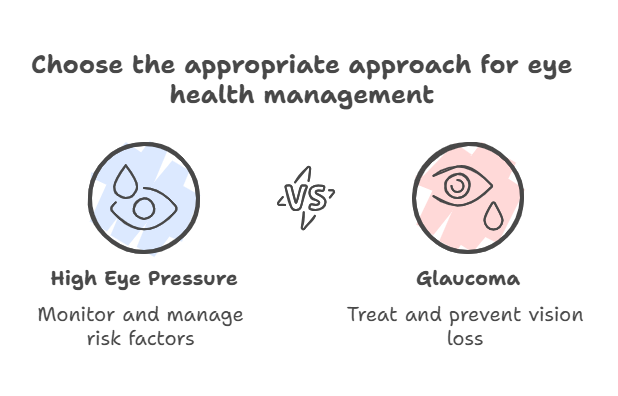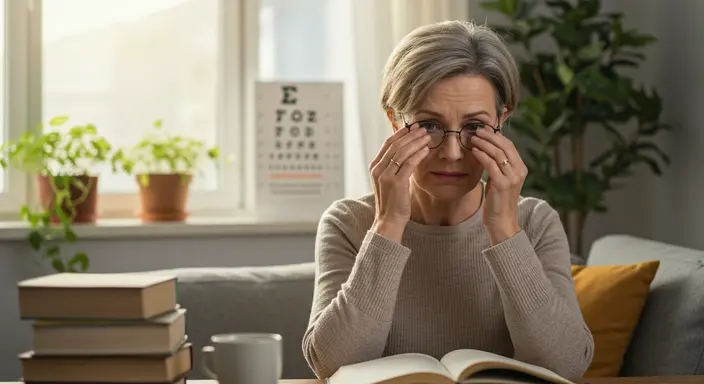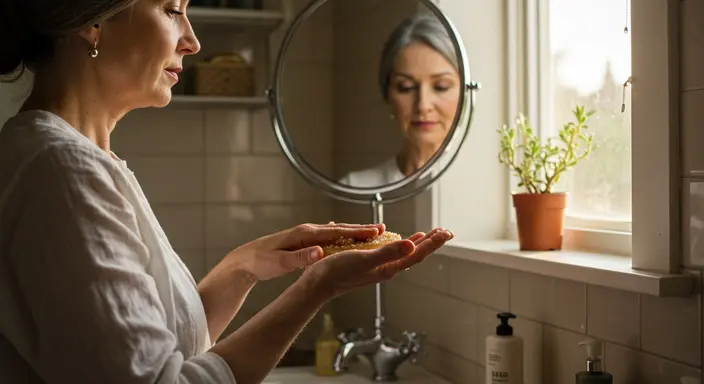You might be wondering about high eye pressure. Perhaps your eye doctor mentioned it, or you’re concerned about glaucoma risk. Understanding the potential signs is important, although often there aren’t any clear symptoms of high eye pressure.
“Ocular hypertension is a silent condition that can lead to glaucoma if left unchecked. Regular eye examinations are essential for early detection and prevention.”
Dr. Anne Coleman
Knowing what this condition involves is the first step towards protecting your vision. This knowledge is crucial even when obvious symptoms of high eye pressure are absent. Recognizing potential risks and the need for monitoring can make a significant difference.
What is High Eye Pressure (Ocular Hypertension)?
Think of your eye like a tiny ball filled with fluid. This essential fluid, called aqueous humor, keeps the eye nourished and helps it maintain its shape. Your eye constantly produces and drains this fluid called aqueous humor to keep the pressure inside balanced and maintain normal eye function.
High eye pressure, technically known as ocular hypertension, happens when this delicate balance gets disrupted. Either your eye makes too much fluid, or more commonly, it doesn’t drain properly through the tissue located in the drainage angle1.
This poor drainage causes the pressure inside your eye, called intraocular pressure (IOP), to rise above the normal range, resulting in elevated eye pressure.
It’s important to know that high eye pressure itself isn’t glaucoma, a condition where the optic nerve suffers damage. But, according to the National Eye Institute, ocular hypertension is a major risk factor for developing glaucoma. Glaucoma is a serious disease where increased pressure damages the optic nerve, potentially leading to irreversible vision loss if not managed.
The Silent Nature of High Eye Pressure
Here’s the challenging aspect: most people with ocular hypertension feel completely fine and notice no changes. They don’t perceive anything wrong with their eyes or vision as the elevated eye pressure builds. This lack of warning signals is why the condition often goes undetected without a comprehensive eye exam performed by eye doctors.
You likely won’t feel the pressure building up inside your eye, leading to increased eye pressure. Unlike high blood pressure, which sometimes causes headaches or dizziness, high eye pressure is typically silent. This absence of perceptible change makes recognizing the need for testing difficult for many individuals.
This is why understanding the potential, though uncommon, symptoms of high eye pressure matters less than recognizing the condition’s typically silent progression. More importantly, it highlights why regular eye check-ups are so vital for everyone. This is especially true for those with known risk factors for developing ocular hypertension or glaucoma.
Potential Symptoms of High Eye Pressure (When They Occur)
While usually symptom-free, some people might experience subtle signs linked to significantly elevated IOP. These aren’t typical for simple ocular hypertension but could point to more sudden pressure spikes or the early onset of glaucoma. It is very rare for high eye pressure alone to cause noticeable feelings or discomfort.
Keep in mind these potential signs are exceptions, not the rule for ocular hypertension. Relying on noticing these possible symptoms of high eye pressure is not a safe way to monitor your eye health or detect elevated eye pressure. Regular exams remain the only reliable method for detection and monitoring2.
Eye Pain or Discomfort?
Generally, ocular hypertension does not cause eye pain. If you experience significant or severe eye pain, it could signal a different, possibly urgent, eye problem. Conditions like acute angle-closure glaucoma involve a rapid, dangerous increase in pressure and require immediate medical attention, often involving a visit to the emergency room.
Angle-closure symptoms of high eye pressure can include sudden, severe eye pain, nausea, vomiting, and blurred vision. Mild aches are sometimes mentioned anecdotally, but these are often unrelated to the IOP itself. Persistent eye discomfort warrants a visit to your eye doctor to find the actual cause and rule out serious eye conditions3.
Don’t simply assume any discomfort is just due to high eye pressure. Proper diagnosis is essential. A thorough examination can determine the source of the pain and guide appropriate action.
Headaches: A Possible Link?
Headaches are not considered a common sign of standard high eye pressure or ocular hypertension. While the extremely high pressure seen in acute angle-closure glaucoma attacks can cause severe headaches alongside nausea vomiting and vision loss, typical ocular hypertension usually doesn’t present this way. These acute symptoms of high eye pressure demand immediate medical care.
If you experience frequent headaches, it’s important to discuss them with your general physician and your eye doctor. While there might be indirect links in some complex cases, blaming headaches solely on elevated eye pressure without a proper diagnosis is generally inaccurate. Many other health factors can cause headaches — learn more about homemade remedies for headaches.
Vision Changes: What to Look For
High eye pressure (ocular hypertension) itself typically doesn’t cause noticeable changes in your vision clarity or field of view. Symptoms of high eye pressure like blurred vision, seeing halos around lights, or losing peripheral (side) vision are hallmarks of glaucoma. These signs indicate that optic nerve damage has likely started, meaning the condition has progressed beyond simple ocular hypertension.
Ocular hypertension represents the stage before this optic nerve damage occurs. If you notice any changes in your vision, such as blurriness or the development of blind spots, schedule an eye exam immediately. These are not typical symptoms of high eye pressure alone but could indicate progression to glaucoma or another serious eye condition4.
Early detection of glaucoma significantly improves the long-term outlook for preserving sight. This is because treatment can be initiated before substantial vision loss occurs. When glaucoma develops, blind spots develop, often starting peripherally, which might go unnoticed initially.
Distinguishing High Eye Pressure from Glaucoma
It’s easy to confuse high eye pressure with glaucoma, but they represent different stages of a potential problem. Think of high eye pressure (ocular hypertension) as a significant warning sign or a risk factor. Glaucoma, on the other hand, is the actual disease process involving nerve damage.
Ocular hypertension means your IOP is higher than the statistically normal range (often considered above 21 mmHg, though this number varies). Crucially, in ocular hypertension, there is no detectable damage to your optic nerve yet, and your peripheral vision, often checked with a visual field test, is still normal. You can have high IOP for years without ever developing glaucoma5.

Glaucoma, however, is defined by characteristic damage to the optic nerve, which transmits visual information from the eye to the brain. As the Glaucoma Research Foundation explains, this nerve damage leads to progressive, irreversible vision loss, usually starting with side vision (peripheral vision loss). While high IOP is the most common cause, it’s not the only one; some people develop normal-tension glaucoma where damage occurs despite having normal eye pressure.
Here’s a table summarizing the key differences:
| Feature | High Eye Pressure (Ocular Hypertension) | Glaucoma (e.g., Open-Angle Glaucoma) |
|---|---|---|
| Intraocular Pressure (IOP) | Elevated (Typically > 21 mmHg) | Often Elevated, but can be Normal (Normal-Tension Glaucoma) |
| Optic Nerve Appearance | Normal, No Damage Detected | Shows Signs of Damage (Cupping, Thinning) |
| Visual Field Test | Normal Peripheral Vision | Shows Peripheral Vision Loss (Blind Spots Develop) |
| Symptoms of high eye pressure | Usually None | Usually None in early stages (Open-Angle); Severe Eye Pain, Nausea, Blurred Vision in Acute Angle-Closure Glaucoma |
| Status | Risk Factor for Glaucoma | Disease involving Optic Nerve Damage |
What Causes High Eye Pressure?
Several factors can raise eye pressure. Knowing these causes helps spot risks, even if the exact reason isn’t clear. The issue often relates to the fluid called aqueous humor in the eye.
A key cause is the aqueous humor itself. The eye may produce too much fluid, filling up faster than it drains. More commonly, the eye’s drainage system, especially the trabecular meshwork at the angle where the iris meets the cornea, may not work properly. This leads to a backup of fluid and increased pressure.
Certain medications can also raise intraocular pressure (IOP). Steroids, whether taken orally, inhaled, or used as eye drops or creams, can increase IOP in some people. It’s important to inform your eye doctor about all current and past medications.
Eye injuries can disrupt the delicate drainage system, leading to higher pressure later on, sometimes months or years after the injury. Some eye surgeries may also cause increased pressure as a complication.
Specific eye conditions can affect fluid drainage. For example, pigmentary glaucoma occurs when pigment from the iris clogs the drainage channels. Pseudoexfoliation syndrome involves flaky material blocking the outflow pathways. Both conditions can significantly raise eye pressure.
Other health issues may influence eye pressure or glaucoma risk. Conditions like diabetes and high blood pressure are linked to increased risk, though the connections are still being studied. Thin corneas can also affect pressure readings and may raise the risk of glaucoma.
Who is at Risk?
High eye pressure can affect anyone, but some groups are at greater risk. Knowing these factors helps you and your doctor understand your situation better. Awareness leads to better eye care and the right screening schedule.
Age is a key factor. People over 40 are more likely to have elevated eye pressure. The risk increases as you age, so regular checks become more important.
Family history is also significant. If your close relatives, like parents or siblings, have ocular hypertension or glaucoma, your risk increases. This is especially true for open-angle glaucoma. Genetics plays a big role in this.
Ethnicity is important too. Research shows that African Americans and Hispanic/Latino people face a greater risk of high eye pressure and glaucoma compared to Caucasians. They may develop glaucoma earlier and face more severe forms of the disease.
Certain medical conditions raise your risk. Diabetes and high blood pressure are linked to elevated eye pressure. Thinner central corneas increase the risk of glaucoma. This is especially true for those with high eye pressure.
High myopia, or severe nearsightedness, is another risk factor. Using steroids for a long time, either orally or on the skin, can greatly raise the risk for those already at risk. Talk to your eye doctor about your medical and family history.
How is High Eye Pressure Diagnosed?
There aren’t often any noticeable symptoms of high eye pressure. Because of this, diagnosis depends on a thorough eye exam by skilled eye doctors. They use several specific tests to check your eye health and measure the pressure in your eyes. This process is usually painless and is vital for early detection.
The main test is tonometry. This procedure measures your intraocular pressure (IOP). You may know the “air puff” test, a type of non-contact tonometry. Your doctor might also use Goldmann applanation tonometry, which is the gold standard. This method uses numbing eye drops. A small, calibrated probe then gently touches your eye. This helps get an accurate reading.
Your doctor will examine your optic nerve for any signs of damage. This often means using special drops to widen your pupils. This helps us see the nerve head at the back of your eye clearly. They check for signs like more cupping or thinner nerve rims. These changes can show early glaucoma.
Pachymetry is another key test. It measures the thickness of your cornea, the clear front part of the eye. Corneal thickness can affect IOP readings from tonometry. Thicker corneas may show high readings, while thinner ones may show low readings. Knowing this helps your doctor interpret the pressure measurements accurately. Thinner corneas are also an independent risk factor for glaucoma progression.
Visual field testing, also called perimetry, checks your side vision. It looks for any defects or blind spots. This test is important. It finds early vision loss from glaucoma. This loss often begins at the edges of your vision. Normal visual field tests suggest ocular hypertension, not glaucoma.
These tests work together to give a complete view of your eye health. They help tell high eye pressure apart from real glaucoma, says the American Academy of Ophthalmology.
Why Regular Eye Exams Are Crucial
Regular dilated eye exams are important. High eye pressure usually has no warning signs. These exams are the only reliable way to spot high IOP before it can harm your optic nerve and lead to glaucoma. Don’t wait for vision issues to show up; damage can happen unnoticed.
How often you need a comprehensive eye exam depends on your age and risk factors. If you’re over 40 or have certain risks, you might need eye exams more often.
This includes:
- A family history of glaucoma
- Being African or Hispanic
- Having diabetes
- Previous eye injuries
Your doctor may suggest exams every 1-2 years. Your eye care professional can help set the best schedule for you.
Catching high eye pressure early lets doctors monitor and treat it on time. This helps lower the pressure. This proactive approach lowers the risk of glaucoma and helps prevent vision loss. Think of these exams as essential maintenance for your vision throughout life.
Even if your eye pressure is normal now, regular checks are still important. IOP can change over time for many reasons. Tracking trends and setting a baseline helps your eye doctor keep your eyes healthy.
Managing Symptoms of High Eye Pressure
If you are diagnosed with ocular hypertension, don’t panic. High eye pressure doesn’t mean you will definitely get glaucoma. Your eye doctor will check your risk using several factors. Your IOP measurement, age, corneal thickness, optic nerve look, and family history all count. Other important factors will also be considered.
Often, the best first step is careful monitoring. Schedule regular eye exams to check your IOP. These exams also examine your optic nerves and visual fields. The frequency of these exams depends on your risk. If your pressure is stable and there’s no nerve damage, you may not need treatment right away.
If your pressure is very high, your doctor might suggest treatment. This is especially true if you have risk factors for glaucoma. These include thin corneas or a strong family history. Signs of early optic nerve changes can also lead to a recommendation for lowering your IOP. The most common starting treatment is prescription eye drops. Trusted sources, like the Mayo Clinic, say these drops reduce eye fluid or help it drain better.
There are different types of eye drops. These include prostaglandins, beta-blockers, alpha-adrenergic agonists, and carbonic anhydrase inhibitors. It’s essential to use the drops exactly as your doctor directs. Consistency is key for managing elevated eye pressure.
In some cases, your doctor may recommend laser therapy. Selective Laser Trabeculoplasty (SLT) helps the trabecular meshwork function better. This improves drainage and lowers intraocular pressure (IOP). Oral medications are not often used for ocular hypertension alone. However, they can be helpful in some cases.
The main goal of any treatment, whether drops or laser therapy, is to lower eye pressure to a safer level. This lowers stress on the optic nerve. It also reduces the risk of glaucoma. Lifestyle factors often affect IOP a little. However, staying healthy is important. Managing blood pressure and diabetes helps keep eyes healthy.
Your doctor will create a management plan tailored to your needs and risk. Regular follow-ups are key. They help track how well the treatment works. They also check for side effects and make necessary changes. If you have concerns or notice changes, don’t hesitate to request an appointment. Keep communication open with your eye care team to stay informed about your eye health.
Conclusion
Understanding high eye pressure means knowing it often has no symptoms. Most people with high IOP won’t feel any signs of the problem. Regular eye exams are vital. They help detect problems early, before any damage occurs.
Catching high IOP, or ocular hypertension, lets you and your eye doctor take action. This may include monitoring or starting treatment to lower eye pressure. Proactive management protects your optic nerve and helps prevent vision loss from glaucoma.
Know your risk factors, like age, family history, and ethnicity. Make regular check-ups with your eye care professional a priority. Taking care of your eyes is important. There are often no symptoms of high eye pressure, so preventive care is key.
Small Step, Big Impact
Regular comprehensive eye exams are crucial, especially since high eye pressure often presents no symptoms. Early detection through routine check-ups can prevent potential progression to glaucoma and safeguard your vision.
Listen to this article
This is an AI generated Podcast version of the article.
- https://www.webmd.com/eye-health/occular-hypertension[↩]
- https://www.aao.org/eye-health/diseases/what-is-ocular-hypertension[↩]
- https://my.clevelandclinic.org/health/diseases/angle-closure-glaucoma[↩]
- https://www.mayoclinic.org/diseases-conditions/glaucoma/symptoms-causes/syc-20372839[↩]
- https://www.ncbi.nlm.nih.gov/books/NBK532237/[↩]



